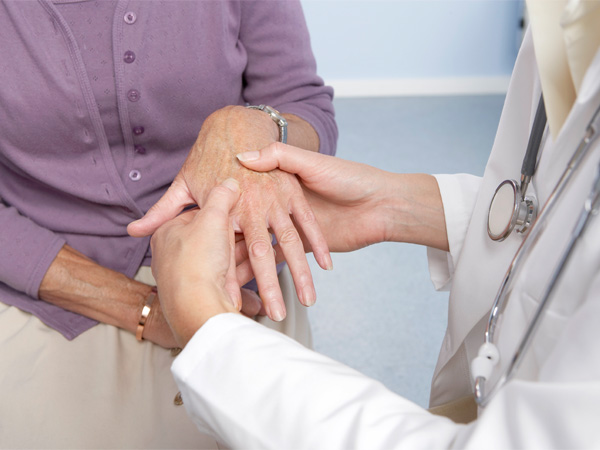- Home
- Science
- Diseases & Conditions
- Rheumatoid Arthritis
What Is Rheumatoid Arthritis?
Rheumatoid arthritis (RA) is a chronic, systemic, autoimmune disease that causes pain, inflammation, and swelling in the joints. This joint disease develops when a malfunctioning immune system attacks healthy joint tissues. Although rheumatoid arthritis primarily affects joints, it can also cause problems in the eyes, lungs, mouth, heart, and blood vessels.1
Prevalence of Rheumatoid Arthritis
About 1.5 million people in the U.S. have rheumatoid arthritis. Those assigned female at birth are nearly three times more likely to be affected than those assigned male. Although there is no cure for rheumatoid arthritis, early treatment can put the disease into remission.2,3
Causes and Risk Factors
What Causes Rheumatoid Arthritis?
A healthy immune system fights pathogens, such as bacteria and viruses, when they invade the body. One of the ways it accomplishes this is by releasing inflammatory chemicals to destroy the pathogen cells.2
In rheumatoid arthritis, the immune system attacks healthy joint tissue called synovium that lines many joints in the body. That tissue produces synovial fluid, which lubricates the bones in a joint, letting them move smoothly against each other. When a person has rheumatoid arthritis, the immune system cells travel to the synovium and attack it, causing inflammation. This, in turn, leads to pain, stiffness, and swelling in the joints. 2

The scientific community is still unsure why this immune system malfunction occurs, but researchers have identified factors and events that can lead to rheumatoid arthritis.1,4
- A combination of genetic risk factors (such as variations in human leukocyte antigen genes) and environmental factors (such as infections or occupational exposure to certain kinds of fibers) may trigger the development of RA.
- An autoimmune malfunction may begin in other parts of the body, but the effects eventually center on the joints.
- The inflammation of the synovium stays persistent, leading it to thicken and eventually cause pain and redness.
Rheumatoid Arthritis Risk Factors
Some risk factors that may make you more likely to develop rheumatoid arthritis include:
- Age
People may develop rheumatoid arthritis at any age, but the risk increases as one gets older. The onset of rheumatoid arthritis in those assigned female at birth is most common between the ages of 30 and 60. Those assigned male at birth rarely develop rheumatoid arthritis before the age of 45.1,2
- Genetics
Scientists have not proved that RA is genetic. But variations in some genes are suspected to be involved in its development. Most noteworthy are variations in human leukocyte antigen (HLA) genes—the HLA-DRB1 gene in particular. Other genes suspected to play a role in rheumatoid arthritis include HLA-B, HLA-DPB1, IRF5, PTPN22, RBPJ, RUNX1, and STAT4.4 Read more about the genetic markers researchers believe may be linked to RA.
- Family history
If you have a relative with rheumatoid arthritis, you may be more likely to develop it.1
- Nongenetic factors
Certain nongenetic and environmental factors have been identified as potential triggers of rheumatoid arthritis. They include changes in sex hormones (specifically estrogens), occupational exposure to certain silica and textile dust, and bacterial or viral infections. Long-term smoking is also associated with the development of rheumatoid arthritis and with more severe symptoms.4,5,6
- Sex
People assigned female at birth are three times more likely than those assigned male to have rheumatoid arthritis.2 This risk may be linked to the part that sex hormones, like estrogens, are suspected of playing in the development of the condition.5
- Obesity
Obesity may increase the risk of developing rheumatoid arthritis. It might also negatively affect the improvement of the disease's activity during treatment.7
Types of Rheumatoid Arthritis
Rheumatoid arthritis is sometimes classified into two categories: seropositive rheumatoid arthritis and seronegative rheumatoid arthritis. This differentiation is based on the presence or absence of an autoantibody known as rheumatoid factor (RF). Patients who test positive for RF are seropositive, while those that test negative for the autoantibody are seronegative. Studies estimate that 45% to 75% of people with rheumatoid arthritis test positive for RF.3
Scientific studies have reported contrasting information on whether seropositive rheumatoid arthritis patients suffer the joint disease more severely than seronegative patients.8
The most common type of arthritis in children, juvenile idiopathic arthritis (JIA) was once known as juvenile rheumatoid arthritis. The name changed because the condition is not the children's version of adult rheumatoid arthritis, but in fact is a heterogeneous group of chronic conditions. The symptoms of some of JIA's subtypes are markedly different from those of rheumatoid arthritis. The cause of JIA is unknown, hence the word "idiopathic," which describes diseases for which there are no known causes. Research, however, suggests that children with JIA may have specific genes that viruses, bacteria, or environmental factors activate.9
There are at least 100 different types of arthritis, which affect about 60 million adults and 300,000 children. Osteoarthritis and rheumatoid arthritis are two of the most common ones.10,11 More than 30 million American adults, over half of which are under age 65 have osteoarthritis and more than 1.3 million Americans have rheumatoid arthritis.11,12 The dissimilarities between rheumatoid arthritis and osteoarthritis begin with their causes. RA is caused when the immune system malfunctions and attacks the body's joints.1 Osteoarthritis results from aging, joint overuse, injury, and the resulting breakdown of cartilage and bone shape changes.11,13
They also differ in symptoms. Rheumatoid arthritis typically affects the wrists, knees, ankles, and small joints in the hands and feet . It is also symmetrical, meaning it affects the same joints of both sides of the body.1,2 Alternatively, osteoarthritis, which does not always develop symmetrically, mainly affects the hands, knees, hips, and joints closest to the tips of the fingers.13,14
Rheumatoid Arthritis Symptoms
Here are some indicative symptoms of rheumatoid arthritis:2
- Pain, tenderness, swelling, and/or stiffness that persists for six weeks or more
- Pain and stiffness that lasts for 30 minutes or longer after you wake up
- Symptoms that affect more than just one joint
- Pain, swelling, and stiffness that are experienced symmetrically, on the same joints on both sides of the body.
- Fatigue
- Low-grade fever
- Initial symptoms affect small joints like those in the hands and feet.

The severity of rheumatoid arthritis symptoms may not always be consistent. Sometimes, they may subside, and other times, the condition could flare, which describes a period of experiencing heightened joint inflammation, pain, tenderness, stiffness, and swelling. A rheumatoid arthritis flare-up can last for days or even months.2
People experience rheumatoid arthritis in different ways. For some, it starts mildly and affects just a few joints.1 Some of the early signs of rheumatoid arthritis are joint tenderness and pain. The joints may not show any redness or swelling at first.2
Rheumatoid Arthritis Complications

Rheumatoid arthritis can cause complications in parts of the body other than the joints.2 Some of these complications include:
- Increased risk of cardiovascular disease15
- Eye pain, dryness, inflammation, redness, light sensitivity, or difficulty seeing properly.2
- Dry mouth and gum inflammation and/or infection.2
- Rheumatoid lung disease, which refers to a group of lung issues linked to rheumatoid arthritis. They include lung scarring, pulmonary hypertension, blockage of the small airways, and fluid around the lungs (pleural effusions).16
- Rheumatoid arthritis nodules. These firm lumps under the skin affect about 30% of people with rheumatoid arthritis. In rare cases, these nodules can be found in the lungs and vocal cords.17
- Anemia as a result of low blood cell count.1
- Increased risk of developing Sjogren's syndrome, an autoimmune disorder with primary symptoms of dry mouth and dry eyes.18
- Blood vessel inflammation, which could result in nerve and skin damage.2
- Increased risk of carpal tunnel syndrome and cervical myelopathy.19
Diagnosis and Treatment
Rheumatoid Arthritis Diagnosis
There's no single test for diagnosing rheumatoid arthritis. A rheumatologist—a doctor that specializes in rheumatic diseases, especially arthritis—is best equipped to make an accurate diagnosis. If you suspect that you might have RA, you may be required to undergo a few key steps.2
Your doctor will ask about your symptoms—when they started, where you currently experience them, and how they may have changed. They will also need information about what medications or self-care activities you've used to alleviate the symptoms. You may be asked to provide a family history.2
The doctor performing the physical will examine your joints and check for swelling, warmth, tenderness, and movement limitations. They will also check for other common symptoms, such as bumps under your skin (rheumatoid nodules) and whether you have a low-grade fever.2
Blood tests can help detect inflammation and antibodies associated with rheumatoid arthritis.2
- Rheumatoid factor test. This checks for the presence of rheumatoid factor, an autoantibody found in the blood of many people with rheumatoid arthritis. Some people with rheumatoid arthritis will test negative for RF, and some people who test positive for RF will never develop RA.1,2
- Anti-cyclic citrullinated peptide (anti-CCP) antibody test. This checks for anti-CCP antibodies. These antibodies are found in approximately 60%-70% of people with RA.2,20 Compared to RF tests, anti-CCP tests are more accurate at diagnosing RA in patients. Both tests are typically used in conjunction with the other during the diagnostic process.20 Moreover, anti-CCP can be found in the body before RA symptoms start to appear, supporting early diagnosis.1
- Complete blood count. This test evaluates the different blood cell counts in the body and is a test used to diagnose anemia. Because many people with RA have anemia, complete bloodr count tests often help identify rheumatoid arthritis.1
- Erythrocyte sedimentation rate (ESR) test. Also called the sed rate test, this test checks for inflammation in the body.1
- C-reactive protein test. This blood test also checks for inflammation in the body. It is used to measure disease activity in rheumatoid arthritis.1
Imaging tests such as X-ray and ultrasound are used to detect tell-tale signs of erosion at the tips of bones in affected joints. They can help measure how severe the RA is and how much damage has been done to the bones. If the imaging tests don’t detect these signs, it could mean that the RA is still in the early stages and hasn't started to cause bone damage.1
Magnetic resonance imaging (MRI) is a powerful imaging tool with more sensitivity than X-rays. MRIs may be used to help detect early-stage rheumatoid arthritis.1
Diagnosing Early-Stage Rheumatoid Arthritis
Rheumatoid arthritis can be challenging to diagnose early, because it sometimes presents with very few symptoms at first. It can also produce symptoms that are similar to other types of arthritis and joint diseases. The further it progresses, the easier it becomes to diagnose. However, early diagnosis and early treatment are ideal for preventing serious complications of rheumatoid arthritis and negative effects on daily living.1
Rheumatoid Arthritis Treatment
Treating rheumatoid arthritis as soon as possible after a diagnosis can help improve your quality of life and avoid permanent joint damage. Rheumatoid arthritis treatment centers on a few goals. The first is reducing inflammation as much as possible to put the disease into remission. Other goals are:2
- Alleviating symptoms
- Preventing, slowing down, or halting damage to the joint
- Preventing or halting complications with and damage to other organs
- Improving mobility
There are many specialists involved in the treatment and management of rheumatoid arthritis. Your care team may include a(n):21
- Rheumatologist
- Primary care doctor
- Occupational therapist
- Physical therapist
- Orthopedic surgeon
- Mental health professional
- Nurse educator
- Dietitian1
Treatment will involve one, some, or all of the following:1
- Pain-relieving and anti-inflammatory. Nonsteroidal anti-inflammatory drugs (NSAIDs) such as aspirin, naproxen, and ibuprofen may be prescribed to relieve pain and lower inflammation. Corticosteroids may also be prescribed to reduce inflammation, slow joint damage, and relieve pain. Corticosteroids are more potent than NSAIDs but also have more serious side effects. For this reason, your doctor will likely prescribe the lowest effective dose.22
- Disease-modifying antirheumatic drugs (DMARDs): DMARDs are prescribed to aid rheumatoid arthritis remission by decreasing inflammation and slowing or halting joint damage and deformity. It may take weeks or months before DMARDs start to be effective.22
- Biologics: Also known as biological DMARDs (bDMARDs), these are prescribed in more long-lasting or uncontrolled cases of rheumatoid arthritis. They become effective very quickly but come with a host of serious side effects, including multiple sclerosis, increased risk of infections, and lymphoma. Like DMARDs, bDMARDs are a second-line treatment prescribed to reduce inflammation and stop joint damage and deformity.22
- JAK inhibitors: These work by blocking Janus kinases, a type of enzyme in cells that increases inflammation. 22
When rheumatoid arthritis medications are used in combination with one another, they may be more effective at preventing or slowing joint damage than when just one medication is used.1
Certain self-care habits and lifestyle changes can help slow down the progression of RA, retain mobility, and ease pain. They include:2
- Engaging in regular exercise
- Getting adequate rest
- Stress reduction and management techniques, such as meditation, massage therapy, and acupuncture
- Maintaining a healthy weight
- Using topical products (like gels and creams) to reduce pain
- Using supplements such as curcumin (turmeric) and omega-3 fish oil supplements. These are sometimes considered natural treatments for rheumatoid arthritis. Some evidence shows that they help with pain and morning stiffness. However, always consult your doctor before using any supplements.
- Smoking cessation
This is an integral part of treating rheumatoid arthritis effectively. Having regular check-ins with a doctor and care team helps them accurately evaluate disease progression, assess the effectiveness of treatments, make changes to treatment plans, and monitor any side effects patients may experience.1
Your doctor may recommend surgery if your rheumatoid arthritis has caused permanent damage or has progressed to the point where you can no longer perform activities of daily life.1 Surgery can help restore function to the affected joints and relieve pain symptoms.22 Surgical procedures that doctors may recommend include joint repair surgery (arthroscopy), joint replacement surgery, and osteotomy.
Surgery is typically considered the last resort in the line of treatments for rheumatoid arthritis.22
There is no rheumatoid arthritis cure. However, these treatment options can help reduce inflammation to the lowest level possible and reach having few or even no symptoms at all.1,3
Global Impact of Rheumatoid Arthritis
According to the World Health Organization, about 18 million people worldwide have rheumatoid arthritis.23
In the U.S., the figure stands at about 1.5 million.2 Data from 2005 to 2018 also shows that, within the U.S., non-Hispanic African Americans and people with lower family incomes had a significantly higher risk of developing RA. Conversely, people with higher education levels had a lower risk.24
In line with data from other regions globally, rheumatoid arthritis is more common in urban areas than rural areas in the Middle East and Africa. The joint disease's prevalence has also been rising in these regions. Since 1990, the prevalence of RA has increased by 13% in North Africa and the Middle East and 14% in western sub-Saharan Africa. The opposite is true for eastern, central, and southern sub-Saharan Africa, where rates have decreased by 4%-12%.25

Frequently Asked Questions About Rheumatoid Arthritis
- Is rheumatoid arthritis an autoimmune disease?
Yes, rheumatoid arthritis is an autoimmune disease that develops when your immune system malfunctions and starts to attack tissues in healthy joints.1
- Is rheumatoid arthritis a disability?
Rheumatoid arthritis is sometimes severe enough to limit a person's ability to perform activities of daily living. This can cause disability.4 In the U.S., the Americans with Disabilities Act (ADA) compels employers to provide reasonable accommodations to qualifying workers. People with rheumatoid arthritis may qualify for such protections if they experience constrained mobility, pain, and moderate to severe arthritis.26 The Social Security Administration also provides disability benefits to people with debilitating arthritis.27
- What is the difference between osteoarthritis and rheumatoid arthritis?
The primary difference between rheumatoid arthritis and osteoarthritis is their cause. Rheumatoid arthritis is caused by an immune system malfunction, while osteoarthritis is caused by aging, joint overuse, and injury.1,13
- How do you test for rheumatoid arthritis?
There is no single test for rheumatoid arthritis. A rheumatologist will make a formal diagnosis after a combination of blood tests, imaging tests, and physical examinations.1
- Is there a cure for rheumatoid arthritis?
No. Currently, researchers have been unable to identify a cure for this condition. But there are several effective treatments that can help increase quality of life for people with RA.1,3
Learn More About Rheumatoid Arthritis
Find a Pfizer clinical trial for rheumatoid arthritis at PfizerClinicalTrials.com.
Explore rheumatoid arthritis clinical trials at ClinicalTrials.gov.
Area of Focus: Inflammation & Immunology
Rheumatoid Arthritis is a focus of Pfizer’s Inflammation & Immunology Therapeutic Area. Visit the Inflammation & Immunology Page.
- References
- Rheumatoid arthritis. National Institute of Arthritis and Musculoskeletal and Skin Diseases. https://www.niams.nih.gov/health-topics/rheumatoid-arthritis. Accessed February 12, 2022.
- Rheumatoid arthritis: causes, symptoms, treatments and more. Arthritis Foundation. https://www.arthritis.org/diseases/rheumatoid-arthritis. Accessed February 12, 2022.
- Chauhan K, Jandu JS, Goyal A, Bansal P, Al-Dhahir MA. Rheumatoid arthritis. StatPearls.
- Rheumatoid arthritis. MedlinePlus. https://medlineplus.gov/genetics/condition/rheumatoid-arthritis. Accessed February 12, 2022.
- Fernanda Romo-García M, Zapata-Zuñiga M, Antonio Enciso-Moreno J, Enrique Castañeda-Delgado J. The role of estrogens in rheumatoid arthritis physiopathology. Rheumatoid Arthritis - Other Perspectives towards a Better Practice.https://www.intechopen.com/chapters/73070. Published August 27th, 2020. Accessed February 12, 2022.
- Mehri F, Jenabi E, Bashirian S, Shahna FG, Khazaei S. The association between occupational exposure to silica and risk of developing rheumatoid arthritis: A meta-analysis. Safety and Health at Work. 2020;11(2):136-142. doi:10.1016/j.shaw.2020.02.001. Accessed February 12, 2022.
- Abuhelwa AY, Hopkins AM, Sorich MJ, Proudman S, Foster DJ, Wiese MD. Association between obesity and remission in rheumatoid arthritis patients treated with disease-modifying anti-rheumatic drugs. Scientific Reports. 2020;10(1). doi:10.1038/s41598-020-75673-7. Accessed February 12, 2022.
- Choi S, Lee KH. Clinical management of seronegative and seropositive rheumatoid arthritis: A comparative study [published correction appears in PLoS One. 2018 Jun 18;13(6):e0199468]. PLoS One. 2018;13(4):e0195550. https://www.ncbi.nlm.nih.gov/pmc/articles/PMC5889180/. Published April 6, 2018. Accessed February 12, 2022.
- Juvenile idiopathic arthritis (JIA). Arthritis Foundation. https://www.arthritis.org/diseases/juvenile-idiopathic-arthritis. Accessed February 12, 2022.
- What is arthritis? Arthritis Foundation. https://www.arthritis.org/health-wellness/about-arthritis/understanding-arthritis/what-is-arthritis. Accessed February 12, 2022.
- Arthritis By The Numbers. Arthritis Foundation. Accessed May 24, 2022. https://www.arthritis.org/getmedia/e1256607-fa87-4593-aa8a-8db4f291072a/2019-abtn-final-march-2019.pdf
- Freeman, J. RA Facts: What are the Latest Statistics on Rheumatoid Arthritis? Rheumatoid Arthritis Support Network. https://www.rheumatoidarthritis.org/ra/facts-and-statistics/. Updated Oct. 27, 2018. Accessed May 24, 2022.
- Osteoarthritis. Arthritis Foundation. https://www.arthritis.org/diseases/osteoarthritis. Accessed February 12, 2022.
- Bergman MJ, Castrejon I, Gibson KA, El-Haddad C, Huang A, Pincus T. Fri0357 patients with osteoarthritis report symmetrical painful joints in similar numbers and distribution as patients with rheumatoid arthritis. Annals of the Rheumatic Diseases. 2015;74(Suppl 2):555-555.
- Aviña-Zubieta JA, Thomas J, Sadatsafavi M, et al. Risk of incident cardiovascular events in patients with rheumatoid arthritis: a meta-analysis of observational studies. Ann Rheum Dis 2012;71:1524–9.
- Rheumatoid lung disease. MedlinePlus. https://medlineplus.gov/ency/article/000113.htm. Accessed February 12, 2022.
- Conforti A, Di Cola I, Pavlych V, et al. Beyond the joints, the extra-articular manifestations in rheumatoid arthritis. Autoimmunity Reviews. 2021;20(2):102735. https://pubmed.ncbi.nlm.nih.gov/33346115/. Published February 2021. Accessed February 12, 2022.
- Dry mouth and arthritis. Arthritis Foundation. https://www.arthritis.org/health-wellness/about-arthritis/related-conditions/physical-effects/dry-mouth-and-arthritis. Accessed February 12, 2022.
- Complications: Rheumatoid arthritis. The National Health Service. https://www.nhs.uk/conditions/rheumatoid-arthritis/complications/. Accessed February 12, 2022.
- CCP antibody test. MedlinePlus. https://medlineplus.gov/lab-tests/ccp-antibody-test/. Accessed February 12, 2022.
- Meet your rheumatoid arthritis health care team. Arthritis Foundation. https://www.arthritis.org/health-wellness/treatment/treatment-plan/you-your-doctor/meet-your-rheumatoid-arthritis-health-care-team. Accessed February 12, 2022.
- Bullock J, Rizvi SAA, Saleh AM, et al. Rheumatoid arthritis: a brief overview of the treatment. Medical Principles and Practice. 2018;27(6):501-507. https://www.ncbi.nlm.nih.gov/pmc/articles/PMC6422329/. Published March 2019. Accessed February 12, 2022.
- Musculoskeletal conditions. World Health Organization. https://www.who.int/news-room/fact-sheets/detail/musculoskeletal-conditions. Accessed February 12, 2022.
- Xu Y, Wu Q. Prevalence trend and disparities in rheumatoid arthritis among us adults, 2005-2018. Journal of Clinical Medicine. 2021;10(15):3289. https://www.ncbi.nlm.nih.gov/pmc/articles/PMC8348893/. Published July 26, 2021. Accessed February 12, 2022.
- Almoallim H, Al Saleh J, Badsha H, et al. A review of the prevalence and unmet needs in the management of rheumatoid arthritis in Africa and the Middle East. Rheumatology and Therapy. 2020;8(1):1-16. https://link.springer.com/article/10.1007/s40744-020-00252-1. Accessed February 12, 2022.
- Know your workplace rights if you have a disability. Arthritis Foundation. https://www.arthritis.org/health-wellness/healthy-living/daily-living/work-life-balance/workplace-rights-disability. Accessed May 31, 2022.
- Arthritis Patients Share How It Hurts. Social Security Matters. https://blog.ssa.gov/arthritis-patients-share-how-it-hurts/. Accessed Aug. 26, 2022.
The information contained on this page is provided for your general information only. It is not intended as a substitute for seeking medical advice from a healthcare provider. Pfizer is not in the business of providing medical advice and does not engage in the practice of medicine. Pfizer under no circumstances recommends particular treatments for specific individuals and in all cases recommends consulting a physician or healthcare center before pursuing any course of treatment.




